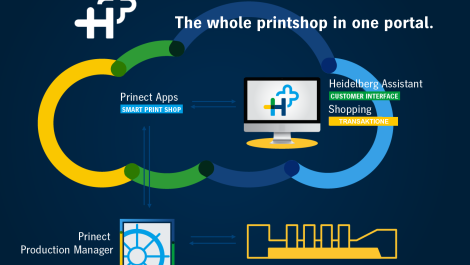The past couple of months has seen significant announcements from major MIS players in the areas of online ordering and marketing, as well as cloud hosting. Simon Eccles provides a catch-up.
Online ordering isn’t news and neither are management information systems. Most MIS suppliers have offered some sort of online ordering system for years, though they haven’t necessarily been in the same league as the dedicated web to print systems.
This is now starting to change, with the announcement in recent months of online systems from Optimus and Tharstern with sophisticated document editing facilities, integrated with the ‘back office’ functions of MIS. Clarity Software has now linked its MIS to its recently announced e-marketing system.
It’s also significant that all of these new functions are remotely hosted (variously called SaaS or cloud servicing), so printers don’t need to install and maintain new servers of their own.
Last year the German developer Hiflex relaunched its whole MIS as a cloud based operation. This certainly attracted attention, not least from HP which bought the whole company in December.
Optimus Cloud
According to Optimus’ managing director Nicola Bisset: ‘We are entering a new age, whereby a seamless and intuitive approach to simplifying and automating print purchasing and having instant access to information, is increasingly being considered by print buyers as mandatory not optional! Equally print providers continue to look at finding solutions to assist them in cutting unnecessary costs through automation, plus finding ways of keeping customer loyalty.’
Most online ordering tools are largely used in isolation, Optimus says. Although online ordering may be a good experience for the buyer, the print provider incurs ‘enormous hidden costs in unnecessary administration and duplication which is error prone and costly.’ Integration with the MIS eradicates these issues, with automation requiring less staff resources at the printer’s end and covering every aspect of customers’ dealings with their print provider, the company says.
Optimus Cloud modules include Variable Data Orders, Fast Orders, Stock Orders, FastQuotes and Customer View. Variable Data Orders allows customers to edit documents through their web browsers. It uses the Dutch NxPublisher system, which allows Adobe InDesign templates to be edited on-screen and output at the print end as either InDesign or PDF documents.
Printers or customers can set up the templates, which are loaded into the Variable Data Orders module and can then be accessed through the web browser. Customers can edit, save, delete and order their documents. Editing functions include copy, paste, save, undo, text, polygons, transparency, alignment, rotation and more.
After the document editing is complete, the job is created and moved to a shopping cart for final order submission. An order is automatically converted into a full production job within the Optimus dash MIS. A print-ready PDF file is generated and transferred to the pre-press system or digital press and the customer receives a notification that the order has been received. All processes are completed with no intervention from the print provider.
Fast Orders is for standard static products. The customer can search through thumbnail lists of predefined jobs and click to order, after which they are converted by Optimus dash into a full production job. Again, no intervention is needed by the print provider.
Stock Orders allow print providers to offer finished goods for order on-line. The customer can view stock levels for call offs, and if there are too few then a new print run can be ordered.
Fast Quotes uses the Optimus dash sales enquiry system to provide quotations on-screen to the print buyer, who can request a hard copy or place the order with one click. An order will appear in Optimus dash as either a full production job or can be held in an order queue for a final check.
Customer View gives the customer a view of sales, financial or production information is available including invoices, jobs in production, jobs finished and delivered, quotations, stock levels and job history, with the ability to re-order a historical job.
Tharstern e4print Pro
This is not Thorsten’s first online ordering system, but it’s the most sophisticated so far and the first to be available as a hosted solution (ie cloud by another name). The company staged a customer launch of e4print Pro at the beginning of February at Manchester United’s Old Trafford stadium and the product is now available. The first two customers had signed up by the end of February, one of which is Hunts People in Print, near Oxford, whose digital press upgrade is also profiled on page 38.
The new e4print Pro introduces on-screen viewing and editing of designs. The document editing system is hosted by Tharstern but integrates with the MIS which still runs on a printer’s local computers.
According to managing director Keith McMurtry, ‘if you are to make online ordering profitable you need to have it totally integrated. You need all the information that is captured upfront, with all the knowledge about the product, the content, delivered in an automated manner all the way through the workflow. So I call this web to workflow, not web to PDF which is essentially what a lot of web to print offers – out of the end is a PDF that is sent downstream and there’s no customer info, no quantities, no reporting, no material allocation.’
‘Variable manufacturing means that users can not only choose a product, but they can say “I want these variations, this size, this number of pages, these post-press variables at the end,” and therefore the pricing becomes variable. There can be a contract price with variables based on quantity, size, number of colours and so on.’
Using e4print Pro, customers can request quotes online and see them instantly, generated by the MIS. Pre-defined questions can be set up for customers to help those who are not particularly familiar with print processes. The user interface is intended to make it easy to search for products or existing stock and to order for single or multiple deliveries.
Electronic copies of job artwork can be generated and delivered as PDF, HTML or other file formats. A shopping basket style ordering process is used, with support for online payment via credit and debit cards or PayPal. Customers can track their current jobs, view management reports by history, stock usage, and spend, and re-order or call off existing stocks.
The online editing and content approval functions are provided by Chili Publisher, a system introduced at the end of 2010 by a Belgian company with an almost identical name, Chili Publish. It was updated last year to version 2.0. This is distributed in the UK by Workflowz.
The Chili Publisher component allows customers to edit predefined templates set up by either their own designers or the printer. Approval is aided by a page-turning system that shows realistic previews of PDFs. The system can also integrate with Agfa Portal or Kodak InSite soft proofing systems where used. Customers can approve or reject jobs online, with the facility to set up a chain of command for proofs and orders to be authorised. Once approved, the artwork goes to the printer and the orders are processed by the MIS.
Ross Edwards, Tharstern’s marketing manager, says: ‘The two-way communication possible enables us to combine variable data with variable manufacture and variable price, something we have never been able to achieve. We can now present our customers with a very powerful integrated solution that is not just web to print but web to workflow. This will help them generate and maximise revenue and profitability via e-commerce.’
Clarity Pro 4.1
Clarity Software, originally called Touch Systems, first developed its MIS in 2001. It was designed from the ground up for digital printing, mainly aimed at large format work but with relevance to commercial print too. Last month saw it announce Clarity Professional 4.1, a significant upgrade which will be demonstrated at the Sign & Digital UK show at the end of March (see pages 32 – 34).
This features enhanced Job Costing and Cost Analysis modules to indicate the true margin on a job, and, Clarity says, to take advantage of the margin ‘uplift opportunities’ that could be hiding in your business. There are new stock management developments in the Goods Handling module, faster quoting speeds with enhanced costing calculators and new Cost Types for precise cost management of outsourced jobs and resources, such as a press or a cutting machine. It also introduces apps for iPhone or Android smartphones.
A lot of wide format media is roll based, and as this is both relatively expensive users and has to be swapped around a lot, it’s important to be able to account for partly-used rolls and offcuts. The v.4.1 Goods Handling module lets users manage their off-cuts and partial rolls to minimise stock wastage.
Another important aspect of v.4.1 is its dynamic integration with Clarity Software’s cloud based e-marketing system, Clarity Marketing. The MIS now synchronises key customer and prospect information with Clarity Marketing in real time via the internet. This means that MIS client information can be accessed and used to build profiled target lists for email and internet marketing campaigns. Clarity Marketing is aimed at any user who needs to generate email and online marketing campaigns, not just those with a Clarity Pro MIS.
Prices start at £10 per month and the system allows users to set up and send branded and personalised bulk email messages. It tracks the open, click-through and forward rates, and creates graphical charts and graphs to present detailed reports. It uses a drag and drop interface to add unique tags to contacts, making it easier to build lists.
According to product director Emerson Welch: ‘e-marketing is one of the most cost- effective strategies currently available to businesses, and we wanted to give SMEs the best chance of reaping the benefits of it, irrespective of their knowledge and proficiency.’
Contacts
Clarity Software: www.claritypro.co.uk
Optimis: www.optimus2020.com
Tharstern: www.tharstern.com




